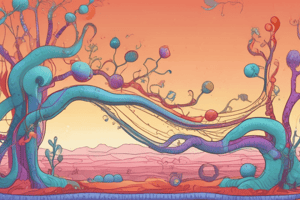Podcast
Questions and Answers
What is the name of the process by which glucose is broken down into pyruvate?
What is the name of the process by which glucose is broken down into pyruvate?
- Glycolysis (correct)
- Citric acid cycle
- Pyruvate oxidation
- Electron transport and oxidative phosphorylation
Where does pyruvate oxidation occur?
Where does pyruvate oxidation occur?
Mitochondria
The citric acid cycle is a series of reactions that take place in the ______ matrix.
The citric acid cycle is a series of reactions that take place in the ______ matrix.
mitochondrial
The electron transport chain is the final stage of cellular respiration.
The electron transport chain is the final stage of cellular respiration.
Which of the following molecules are involved in both the citric acid cycle and electron transport chain?
Which of the following molecules are involved in both the citric acid cycle and electron transport chain?
At the end of the electron transport chain, what is the final electron acceptor?
At the end of the electron transport chain, what is the final electron acceptor?
What is the primary purpose of cellular respiration?
What is the primary purpose of cellular respiration?
Flashcards
Aerobic Cellular Respiration
Aerobic Cellular Respiration
The process by which cells break down glucose to produce energy in the form of ATP. It requires oxygen to complete.
Glycolysis
Glycolysis
The first stage of cellular respiration, where glucose is broken down into two pyruvate molecules. It occurs in the cytoplasm.
Substrate-level phosphorylation
Substrate-level phosphorylation
The transfer of a phosphate group directly from a substrate molecule to ADP, forming ATP. This is a direct way to generate ATP.
Pyruvate
Pyruvate
Signup and view all the flashcards
Pyruvate Oxidation
Pyruvate Oxidation
Signup and view all the flashcards
Citric Acid Cycle (Krebs Cycle)
Citric Acid Cycle (Krebs Cycle)
Signup and view all the flashcards
NADH
NADH
Signup and view all the flashcards
FADH2
FADH2
Signup and view all the flashcards
Electron Transport Chain and Oxidative Phosphorylation
Electron Transport Chain and Oxidative Phosphorylation
Signup and view all the flashcards
Oxidative Phosphorylation
Oxidative Phosphorylation
Signup and view all the flashcards
ATP
ATP
Signup and view all the flashcards
Oxygen (O2)
Oxygen (O2)
Signup and view all the flashcards
Mitochondria
Mitochondria
Signup and view all the flashcards
Study Notes
Cellular Respiration
- Cellular respiration is a process that breaks down glucose and other fuel molecules to produce ATP.
- This process occurs in four stages: glycolysis, pyruvate oxidation, citric acid cycle, and electron transport and oxidative phosphorylation.
Glycolysis
- Occurs in the cytosol.
- Breaks down glucose into two pyruvate molecules.
- Produces some ATP via substrate-level phosphorylation.
- Produces NADH.
Pyruvate Oxidation
- Occurs in the mitochondria.
- Each pyruvate molecule is oxidized, releasing CO2, producing NADH, and forming an acetyl group that combines with coenzyme A (acetyl-CoA).
Citric Acid Cycle
- Occurs in the mitochondria.
- Acetyl-CoA molecules enter the cycle.
- The acetyl group is completely oxidized to CO2.
- ATP is produced via substrate-level phosphorylation.
- Electron carriers NADH and FADH2 are produced.
Electron Transport and Oxidative Phosphorylation
- Occurs in the mitochondria.
- Electron carriers NADH and FADH2 transfer electrons.
- This process creates a proton gradient across the inner mitochondrial membrane.
- Energy from the gradient is used to synthesize ATP via oxidative phosphorylation.
- Oxygen is the final electron acceptor, forming water
ATP Production
- Substrate-level phosphorylation transfers phosphate groups directly to ADP, forming ATP.
- Oxidative phosphorylation uses the energy from electrons to indirectly produce more ATP.
Studying That Suits You
Use AI to generate personalized quizzes and flashcards to suit your learning preferences.




